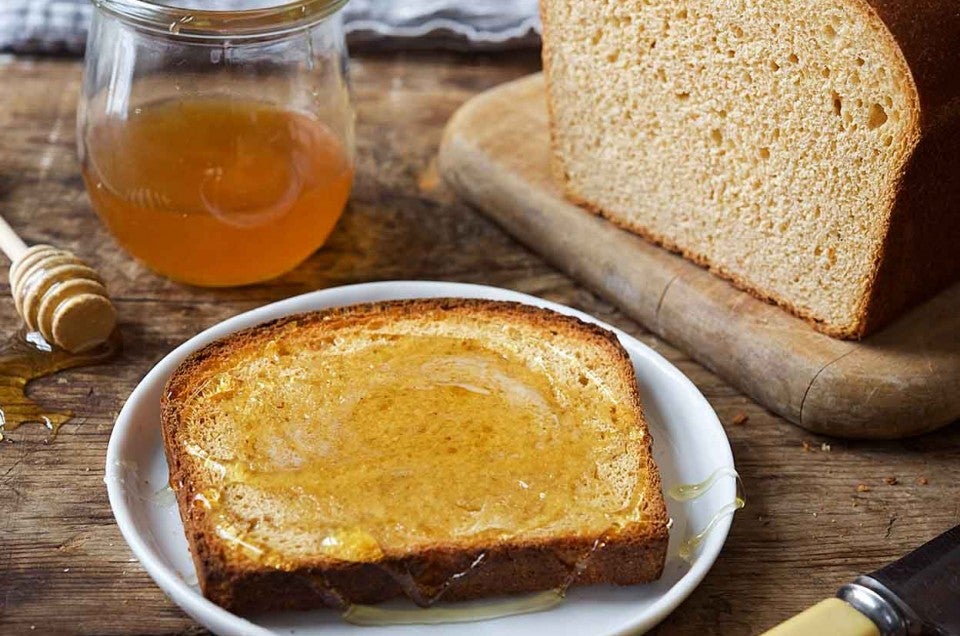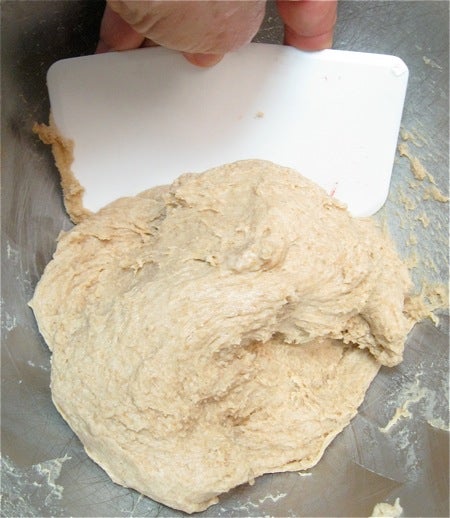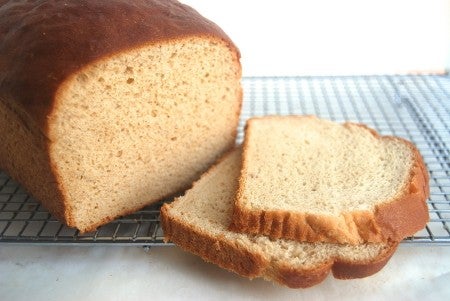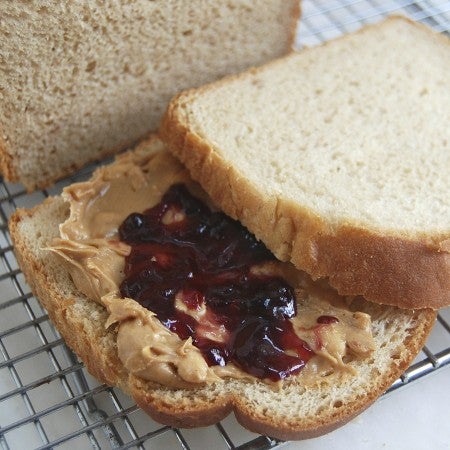


With all the recipes we have for decadent chocolate goodies, crusty artisan breads, delicious pies, and tender-tasty cakes, it's a recipe for humble whole wheat bread that gets the most clicks.
And it makes sense when you think about it. Many people want to eat healthy. There are a lot of bread bakers out there. And King Arthur whole wheat flour is the top-selling whole wheat flour in America.
So it stands to reason we'd have a recipe for the best 100% whole wheat sandwich bread you've ever tasted.
That's right - 100% WHOLE WHEAT sandwich bread. No white flour at all.
Yet it's moist, close-grained, slices like a dream... And, oh yeah, let's not forget the taste: slightly nutty, rich, barely sweet.
This is the perfect whole-grain sandwich and toasting bread. And YOU can make it at home. Honest!
What's the secret to great whole wheat bread? First, the flour. Yeah, as an employee-owner at King Arthur Flour, I'm patting myself on the back here; but we do buy and mill the BEST wheat in America. If you missed this video of the Kansas farms and farm families we work with from an earlier blog, take a look:
When you start with great flour, the rest falls into place easily. Yeast, water, salt, a sweetener; milk, for texture and nutrition; oil, to keep the bread fresh. And that's all it takes to successfully make whole wheat sandwich (and toasting) bread.
Those ingredients, plus one more: this recipe for Classic 100% Whole Wheat Bread, vetted and enthusiastically approved by your fellow bakers. (Don't just take my word for it; check the 5-star reviews!)

Put the following in a mixing bowl:
1 to 1 1/8 cups (227g to 255g) lukewarm water*
1/4 cup (50g) vegetable oil
1/4 cup (85g) honey, molasses, or maple syrup
3 1/2 cups (397g) King Arthur Premium 100% Whole Wheat Flour
2 1/2 teaspoons instant yeast, or 1 packet active dry yeast dissolved in 2 tablespoons of the water in the recipe
1/4 cup (28g) Baker's Special Dry Milk or nonfat dried milk
1 1/4 teaspoons (8g) salt
*Use the greater amount in winter or in a dry climate; the lesser amount in summer or a humid climate.

Combine all of the ingredients and mix till the dough starts to leave the sides of the bowl.

Knead the dough for 6 to 8 minutes, or until it begins to become smooth and supple. It should be soft, yet still firm enough to knead. Adjust its consistency with additional water or flour, if necessary.
It was rainy and humid the day I made the bread for this blog; and the dough was kind of sticky.

So I stopped the mixer midway through the 7-minute knead I was giving it, and scraped the sticky dough into the center of the bowl.

Like this.

After kneading for a few more minutes, it was less sticky... though still quite soft.
That's OK. You know why? Up to a certain point, the stickier/softer your dough, the higher it'll rise. Resist the urge to keep adding flour to sticky dough; in the long run, you do yourself a favor by simply putting up with a certain amount of stickiness.
How sticky is TOO sticky? If you shape the dough into a log and it slowly starts to flatten into a pancake, that's too sticky. It can relax a bit, like someone settling into a chair; but it shouldn't flatten out.

Transfer the dough to a lightly greased bowl or large measuring cup, and cover the container.

Allow the dough to rise till very puffy – about 1 to 2 hours, depending on the warmth of your kitchen.

Transfer the dough to a lightly oiled work surface, and shape it into an 8” log. Place the log in a lightly greased 8 1/2” x 4 1/2” loaf pan, and cover the pan loosely with lightly greased plastic wrap. Or a handy-dandy shower cap from the dollar store, as I've done here.

Allow the bread to rise for about 1 to 2 hours, or till the center has crowned about 1” above the rim of the pan. WOW - that's quite a nice rise for whole wheat bread, isn't it?
Towards the end of the rising time, preheat the oven to 350°F.

Bake the bread for 20 minutes...

...and check to see how brown it is. If it's nearly as brown as you like...

...tent it lightly with aluminum foil. Continue to bake for 15 to 20 minutes, then remove it from the oven.

The finished loaf will register 190°F on an instant-read thermometer inserted into the center.

Turn the loaf out of the pan, and rub a stick of butter over the crust, if desired.

The butter will soak in, yielding a soft, flavorful crust, and a beautiful, satiny finish.

Slice when completely cool. Store the bread in a plastic bag at room temperature.
Accept your family's compliments on the best whole wheat sandwich bread you've ever made.
And what if your family doesn't like even this soft, moist, close-grained whole wheat loaf?

Try substituting 1 1/2 cups (6 1/4 ounces) King Arthur Unbleached All-Purpose Flour for 1 1/2 cups of the whole wheat. The bread will be just slightly lighter-colored; firmer/easier to slice; and less "wheaty" tasting.

Perfect for a PB&J!
And here's one more hint, for those of you who turn up your nose at whole wheat's "wheaty" flavor: try substituting 1/4 cup orange juice for 1/4 cup of the water in this recipe. The OJ tempers the wheat's assertive taste, without adding any orange flavor of its own.
Read, rate, and review (please) our recipe for Classic 100% Whole Wheat Sandwich Bread.
Happy baking!


January 2, 2022 at 2:13am
Can I use whole wheat bread flour for this recipe ?
January 5, 2022 at 4:02pm
In reply to Can I use whole wheat bread… by Bonnie Chung (not verified)
Hi Bonnie,
Yes, a whole wheat bread flour would be just fine in this recipe. Happy baking!
November 7, 2021 at 9:50pm
Tried to bake this and it was a no-go. The dough was extremely sticky and never pulled away from the mixing bowl. Not much of a rise either...about 1/4 inch and that fell during the second rise. I feel like a failure
November 8, 2021 at 11:26am
In reply to Tried to bake this and it… by Kenneth L Smith (not verified)
Hi Kenneth, please don't feel like a failure! Baking, just like any craft, involves a fair amount of learning from your mistakes, but we want to try to help you avoid common pitfalls whenever we can! It sounds like your dough might have been a little over-proofed if it fell during the second rise. This blog on desired dough temperature can be helpful when it comes to controlling the rate of your rise and guarding against over-proofing. If you're able to give our Baker's Hotline a call at 855-371-2253, we'd love to help you troubleshoot further, and make sure that your next bread making adventure is a much better experience!
October 31, 2021 at 10:00am
In the recipe https://www.kingarthurbaking.com/recipes/classic-100-whole-wheat-bread-… in instruction 5 it says to "gently deflate the dough". Can you explain that meaning, and what it should look like?
October 31, 2021 at 10:27am
In reply to In the recipe https://www… by Kenneth L Smith (not verified)
Hi Kenneth, we recommend folding the dough in this manner as a way of gently deflating it.
October 6, 2021 at 7:53pm
A few years ago, I started milling my own flour, and have been using a combination of the hard red and soft white wheat berries. Usually the problem I have with not adding bread flour or all-purpose flour is that the bread turns out very crumbly and dry, making it hard to use. Also it never rose much at all. I have tried every "trick" to make it rise (adding vital wheat gluten, vitamin C, etc.), BUT I've never seen a recipe that called for kneading with oil instead of more flour. Until now. I think I was also using too much flour, and not giving it the 20 minutes in the beginning to absorb the liquid. I never knew about that step. It's on it's first rise now, and I have "high hopes" for this loaf. So far, so good!! I can't wait to see how it turns out. I make bread all the time, and love making my own "hot pockets". They are delicious, and sometimes the only way to make sure the bread doesn't fall apart while it's being eaten since the fillings are already inside it. Thank you for changing my life!
August 24, 2021 at 7:29am
Hi, will it be ok to use olive oil for this recipe? Thank you.
August 24, 2021 at 11:13am
In reply to Hi, will it be ok to use… by Lanie (not verified)
Hi Lanie. Using olive oil in the same amount to replace the vegetable oil in this recipe will be a fine substitute. Happy Baking!
April 22, 2021 at 4:57pm
I just made this and I probably should have asked this before baking but I figured I would give it a try anyway and see what happens. So I made the dough with my bread machine and turned it out into a separate pan for baking. I followed the steps in the recipe but my bread, even though it rose in the pan, looks like it's flattening out as it cools. It tastes wonderful but it either feels very slightly underdone (I don't have a digital thermometer) or it didn't rise as well as it should have. Now I'm questioning a couple of the steps and how I followed them. The yeast: do you dissolve either one in 2 Tbsp of the water called for? Or only just the active dry yeast? I dissolved the correct amount of instant in the water and then added it but maybe I wasn't supposed to? And when it's in the bread machine going through the dough cycle, was I supposed to proof it again after the cycle is completely done (when the timer goes off)? Or was it okay to skip right to forming the log and putting it into the pan? I have more than enough to make this again (which I will) but would like some feedback before I do. Thank you so much!
Pagination